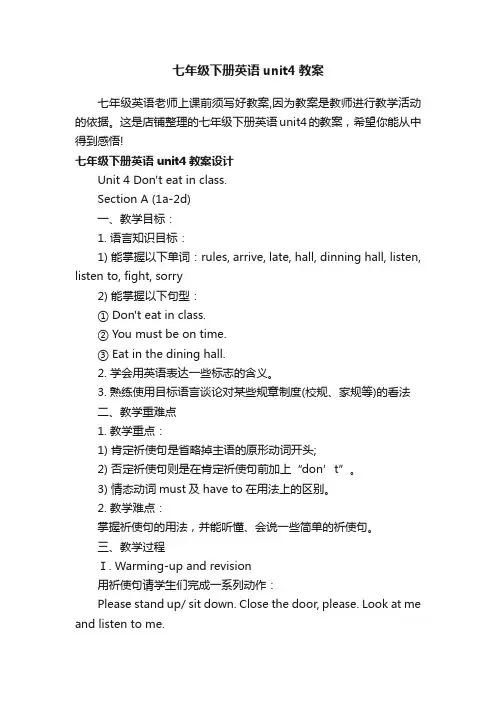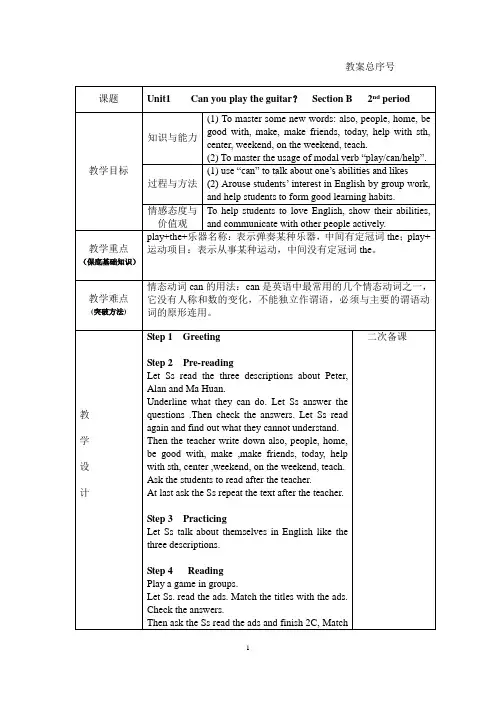七年级英语下册Unit1-4教案
七年级下册英语unit4教案

七年级下册英语unit4教案七年级英语老师上课前须写好教案,因为教案是教师进行教学活动的依据。
这是店铺整理的七年级下册英语unit4的教案,希望你能从中得到感悟!七年级下册英语unit4教案设计Unit 4 Don't eat in class.Section A (1a-2d)一、教学目标:1. 语言知识目标:1) 能掌握以下单词:rules, arrive, late, hall, dinning hall, listen, listen to, fight, sorry2) 能掌握以下句型:① Don't eat in class.② You must be on time.③ Eat in the dining hall.2. 学会用英语表达一些标志的含义。
3. 熟练使用目标语言谈论对某些规章制度(校规、家规等)的看法二、教学重难点1. 教学重点:1) 肯定祈使句是省略掉主语的原形动词开头;2) 否定祈使句则是在肯定祈使句前加上“don’t”。
3) 情态动词must及have to在用法上的区别。
2. 教学难点:掌握祈使句的用法,并能听懂、会说一些简单的祈使句。
三、教学过程Ⅰ. Warming-up and revision用祈使句请学生们完成一系列动作:Please stand up/ sit down. Close the door, please. Look at me and listen to me.Don’t open your books. Don’t talk. Let’s begin our class.Ⅱ. 1aT: Now, Look at the picture on your textbook. Each of the students is breaking one of these rules. Please finish 1a.Ⅳ. ListeningNow let’s listen! What rules are these students breaking? Write the numbers after names?Ⅴ. Pair wo rkRead the dialogue in 1cand work in pairs.Ⅵ. Listening1. First, let's read the sentences in 2a together. Now, let's listen to the recording. Check the activities Alan and Cindy talk about.2. Work on 2b: Listen to the recording again. Can Alan and Cindy do these activities? Circle can or can't above.Ⅶ. Pair work1. Suppose you are Alan and your partner is Cindy. Talk about the rules in 2a.2. Let some students come to the front and act out the conversations.Ⅷ. Role-playRead the conversation and find some rules in this school. Ss read the conversations and find the answers to this question.( Don't be late for school. Don't bring music players to school. You always have to wear the school uniform. You have to be quiet in the library. )Homework:1. Remember the new words and expressions.2. 完成下列句型转换试题1)I can play computer games on weekends.(一般疑问句)_________________________________? Yes, ____________.2) He has to wear uniform.(变否定句) He _____ _____ _____ wear uniform.3) I have to wear sneakers for gym class.(一般疑问句)_____ you ____ ____ wear sneakers for gym class? Yes, I ____.4) They have to wash clothes.(提问) ____ do they have ____ ____?5) You can’t go out on school nights.(换一种表达) _______ go out on school nights.6) Don’t talk in class.(同上) No _________.Section A (Grammar Focus-3c)教学重难点1. 教学重点:1) 继续学习使用目标语言谈论对某些规章制度(校规、家规等)的看法2) 通过不同方式的练习方式来学会用英语表达一些标志的含义。
人教版,英语,七年级下册,unit1,第四课时,电子教案

价值观
To help students to love English, show their abilities, and communicate with other people actively.
教学重点
(保底基础知识)
play+the+乐器名称:表示弹奏某种乐器,中间有定冠词the;play+运动项目:表示从事某种运动,中间没有定冠词the。
教案总序号____
课题
Unit1 Can you play the guitar?Section B2ndperiod
教学目标
知识与能力
(1) To master some new words: also, people, home, be good with, make,make friends, today, help with sth, center,weekend, on the weekend, teach.
Step5 Writing
Pre-writing:plete the ad with the words in the box.
Writing: 3b. Make a poster. Ask for help with an event at your school.
Step6Practice
Ask the students to read after the teacher.
At last ask theSs repeat the text after the teacher.
Step 3Practicing
Let Ss talk about themselves in English like the three descriptions.
七年级英语下册《Unit1Canyouplaytheguitar》教案(新版)人教新目标版

Unit 1 Can you play the guitar?Section A (1a-2d)一、教学目标:1. 语言知识目标:1) 能掌握以下单词:guitar, sing, swim, dance, chess, play chess, draw, speak, speak English, join, club 能掌握以下句型:①—Can you play the guitar? —Yes, I can./ No, I can't.②—What can you do? —I can dance.③—What club do you want to join? —I want to join the chess club.2) 能了解以下语法:情态动词can的用法want to do sth.的用法2. 情感态度价值观目标:该部分内容贴近学生的生活,谈论的话题是能力。
通过互相询问或谈论自己或对方在某一方面的能力,可以培养学生的一种群体意识。
二、教学重难点1. 教学重点:1) 学习询问和谈论彼此的能力和特长;2) 掌握一些弹奏乐器的表达方式。
2. 教学难点:情态动词can的构成和使用。
三、教学过程Ⅰ. Lead in1. 教师可携带一些易于演奏的乐器,也可带一些演奏乐器的图片,一边演示乐器,一边说: I canplay the guitar.…等;再指着图片说:He/She can play the violin.But I can’t play it.等;然后询问学生:Can you play the guitar?….并引导学生进行简单的回答。
2. Ss look at the picture in 1a. Then read the words and phrases. Let Ss match the activitieswith the people.Then Check the answers with the class together.Ⅱ. Presentation出示一些反映各种活动的图片、幻灯片或播放课件,引导学生谈论活动:He/She can dance/swim/sing/"··But I can’t dance/swim/sing/...等,学习表达活动的动词短语。
冀教英语七年级下教案Unit 1 Lesson 4 A Visit to Lanzhou

冀教英语七年级下教案Lesson 4 A Visit to Lanzhou 课时目标自主学习一、根据句意及汉语提示写出单词。
1.Ourgroup(团体)members all want to take part in the football game.2.Let's take(乘)a train to Beijing.3.She often helps the old tocross(横穿)the road.4.With the spread of Chinese culture,Chinese iswidely(广泛地)used in the world. 5.—When was the new cross-seabridge(桥)in Lianyungang completed?—In April,2016.二、写出下列画线短语的汉语意思。
1.Later,they go for a walk along the Yellow River.散步2.Let's go down this street and turn left at the traffic lights.沿着……走;向左转3.Can we take a picture in front of the statue,Ms.Martin?照相;在……前面4.This road will lead us to the Yellow River.指引我们到黄河教学过程环节1新课导入教师通过PPT呈现如下图片,让学生进行讨论。
设计意图:图片展现了与兰州旅行相关的内容,教师让学生讨论这些图片可以顺利过渡到这节课的学习中来。
环节2新课学习1.教师让学生浏览一遍对话,了解对话的主旨,然后教师邀请一名学生说一说对话大意。
2.教师让学生精读对话,深入理解对话内容。
并勾画出对话中重要的知识点及难点,教师进行一一讲解,然后对Culture Tip这一块作简要讲解。
七年级下册英语全册教案(外研版)

Module 1 School LifeUnit 1 There are fifty students in the class.Preparation在黑板上写出单词Festival,要求学生回忆并说出已学过的节日名称,如:New Year, Christmas Day等,并板书。
组织两人小组活动,内容是在节日时的对话。
如下例:Happy New Year...Happy New Year...Do you...?Yes/No. We...两人小组活动后,请几对学生上台演示,然后要求大家评价。
对演示认真又基本无语言错误的学生给予奖励。
介绍短语Spring Festival, 带读后转入第1小节的学习1.Look and listen. Then repeat.1)先不打开书,问学生:春节后,一些同学又见面了,他们很高兴地在一起交谈,他们谈了些什么呢(What are they talking about ?)?2)要求学生听一遍录音后,回答上面的问题,然后将答案School Life 写在黑板正上方。
3)写出以下问题,要求学生听第二遍录音后回答:How many students are there in the class?How long are the lessons?How does Feifei go to school?How long does the bus take to get to school ?学生回答上述问题后翻开书,跟录音读一遍对话。
组织四人小组操练本段对话,然后要求他们演示和评价。
第2、3、4小节的教学可参考“教师用书”的建议进行。
Unit 2 What’s your favourite lesson?Preparation1)教师先简单用英语介绍本班的一些情况,然后要求学生分两人小组就School life话题进行对话,也可以给出以下问题要求学生对话:Do you like your school?How many lessons do you have each day?How do you get to school?两人小组活动后,叫几对学生上台演示,然后要求大家评价。
七年级下册英语Unit 4单元教案(人教版)

2. Work on 2b:
Make Sure Ss know what they should do.
Listen to the recording again. Can Alan and Cindy do these activities? Circle can or can't above.
课型
新授
课时
4
教材分析
本部分重点是祈使句的用法。在本节课里通过活动与配图,引出本部分中关于“学校的规章制度”及否定祈使句。
学情分析
在以前的学习中,只是将情态动词can用于“谈论能力”。而在本部分我们利用情态动词can,must,have to来谈论一些规章制度。
教
学
目
标
1. 语言知识目标:
1) 能掌握以下单词:rules, arrive, late, hall, dinning hall, listen, listen to, fight, sorry
1. Ss work by themselves and try to write the sentences on the workbook.
教
学
目
标
1. 语言知识目标:
1) 继续练习运用如何做自我介绍及问候他人。学会从对话中获取对方的基本信息(询问他人姓名)。 能掌握以下句型:
①Don't eat in class.
②You must be on time.
③Eat in the dining hall.
2. 情感态度价值观目标:
该部分继续学习使用目标语言谈论对某些规章制度(校规、家规等)的看法。
七年级英语下册unit 1-4教案
七年级下册教案Unit1 Where is your pen pal from?Teaching Goal:Topic:Countries, nationalities, and languagesGeneral aims:A. Talk about where people are fromB. Talk about nationality, nation and languageC. Talk about where people liveFunctions:Talk about countries, nationalities and languagesAsk and tell about where people liveTarget language:A. Language Focus.(1). Talk about nationality, peoples and languages/(2). Ask and answer where people live.B. Language goals(1). Change your own information with your pen pals.(2). Ask some questions using where.(3). Ask words somebody talk about.C. Language structure:Where’s/Where’re ...from?Where does/do ...from?What questions----What language does/do ...speak?D. Language points:Where is she from? She is from....Where does she live? She lives in....What language does she speak? She speaks....Vocabulary:Words about countries, languagesTeaching design:The whole unit needs 5 periods, 4 for new lessons and 1 for testPeriod 1 ( 1a----Grammar Focus )Key points:Where is your/John's pen pal from? He/She is from...Where does he/she live? He/She lives in....Pre-task (Homework for preview):Let the Ss give themselves pen pals and they should write down their pen pals' information, such as their names, countries and cities they live even the language they speak.T can give the Ss an example meanwhile T gives the different countries which can be used by the Ss. T gives the Ss Chinese words for the countries, they are following: 加拿大,法国,日本,美国,澳大利亚,新加坡,英国,中国( The Ss can look them up in the dictionary if they are new for them)The example is following:Name: Curry MurayAge: 75From(Nationality): the United StatesCity: New YorkLanguage: EnglishTeaching Steps:Step 1 Leading-in The information of the teacher's own pen pal's information.“I have a pen pal. His name is Curry Muray. He is from the United States. Do you have a pen pal? Where is your pen pal from? What's your pen pal's name?”Different students say the information about their own pen pals. T should choose the different countries. T writes the different countries on the Bb(both Chinese and English)Step 2 LearningSection A 1a Learn the new words on the Bb. The new words are:pen pal; Canada; France; Japan; the United States(the US/the USA/America); Australia; Singapore; the United Kingdom(the U.K./Great Britain/England)Pay attention to the pronunciation of the new words.Step 3 Listening1b Listen and circle the countries in 1a they learnedStep 4 CompetitionTwo groups of students to write the new words to see which group does better. First write down the Chinese words with looking at the English meanings, then write down the English words with looking at the Chinese meanings.(This step is a memory game. It can help the Ss consolidate the new words they learned)Step 5Pair work1c Practice the following conversation:---Do you have a pen pal? ---Yes, I do.---Where’s your pen pal’s from? ----He/She is from .... (Write it down on the Bb)First T has a conversation with one student as an example then let the Ss practice in pairs.At last let several pairs do it again in class.Step 6Leading-inRevise the countries names with looking at the Bb. Then T writes down the city names on the Bb. Let the Ss try to find out which countries the cities are in. The city names are following:Toronto; Paris; Tokyo; New York; Sydney; Singapore; LondonStep 7 Learning2a Learn the city names together with the whole class just like Step 22b Listen and circle the cities and countries2c Listen and complete the chartHave a similar competition to consolidate the new words in this part.Step 8Pair workT has a conversation with one student like the following:---Do you have a pen pal? ---Yes, I do.---What's your pen pal's name? ---His/Her name is....---Where is your pen pal from? ---He/She is from...---Where does he/she live? ---He/She lives in....(Write it down on the Bb)Let the Ss practice after the T's example in pairs then several pairs do it in class.Step 9Exercise1. My pen pal is from Australia.(划线提问)2. John’s pen pal is from Japan. (划线提问)3. He lives in Paris. (划线提问)Homework:Read and copy the new words .Copy the sentences in Grammar FocusMake up the questions about Jodie in 2c The questions are:Does Jodie have a pen pal? Where is Jodie's pen pal from? Where does he/she live? What's his/her name?(This one can be chosen by themselves)Period 2 (3a----Section B 2c)Preview(Pre-task):Add another information about their pen pals----their language on the cardKey points:What langu age does she/he speak? She/He speaks….Does she/he have any brothers and sisters?Does she/he speak English?Teaching Steps:Step 1 Revision1. Revision and dictation of the new words2. Revise the drills they learned yesterday.(by pair work and grammar exercise)Step 2 Leading-inT has a conversation with one student. The conversation is following:---Do you have a pen pal? ---Yes, I do.---What’s your pen pal’s name? ---His/Her name is….---Where is your pen pal from? ---He/She is from…---Where does he/she live? ---He/She lives in….---What language does he/she speak? He/She speaks…Write the new words on the Bb. They are following: English Chinese Japanese FrenchStep 3 LearnLearn the new words with the whole class.Finish 3a with the students3b Pair work T still does an example with one student Then the Ss practice in pairs.The example is following:--Curry Muray is my pen pal. He is from the United States.---What language does he speak?---He speaks English.Step 4 Practice1. Section B 1a Match the countries with their languages.2. Memory game Let the Ss repeat the following sentences:People in China speak Chinese. People in Japanese speak Japanese. People in the USA, UK, Australia and Canada speak English. People in Singapore speak English and Chinese. People in France speak French.3. 2a Listen and number the questions they hear4. 2b Listen again and write short answers to the questions in 2a(Good students can finish the two tasks for one time)Step 5 Pair workPractice the conversation of 2a in pairsPay attention to the language points:Does she have any brothers and sisters? (any and)Does she speak English? (Write them on the Bb)2c The Ss makes up their own dialogue about more information of their pen pals by using the drills in 2a. Step 6 Group workFour students as a group make a survey about pen pals by asking and answering each other.Their questions are about their pen pals’ names, nationalities, cities, languages and their favorite subjects or more informationAt last if time possible several students do the report in class about their surveys.Step 7 HomeworkCopy the new words they learned today and the sentences in 2aGood students can write a report about their surveys about pen pals of their own groups.Period 3(3a----3c) A reading lessonStep 1 Revision1.Revision and dictation of the new words and expressions2.Revise conversations they learned yesterday.3.Revise the key points by grammar exerciseHe speaks English. (变一般疑问句和特殊疑问句)Step 2 Reading3a Read the letter and write answers to the questions in the box.Read it again and let the Ss discuss in groups(4 as a group) to design an information card for Bob.Let the Ss read aloud. First after the T or the tape then by themselves.T must make sure the Ss can read it correctly and fluently.T write the key words on the Bb to help the Ss retell the letter.The key words are following:Bob, Toronto, want, a very interesting country, 14, in Nov., can speak, brother, Paul, sister, Sarah, pen pals in the UK and A ustralia, like going …and playing…, favorite subject, fun, math, difficult, write toLearn the language points in the letter:1)I want a pen pal .want sth./sb.( musician wanted)want to do sth. I want to play soccer with my friends.want sb. to do sth. My parents want me to do homework now.2)I like going to the movies …3)My favorite subject in school is…4)write to sb. soonStep 3 Practice3b Complete the pen pal letter with the information on the card.Step 4 Writing1.Make an information card just like the card in 3b .2.Write a letter or an e-mail to your pen pal.Step 5 HomeworkWrite a letter or an e-mail to your pen pal.Period 4 (Self-check)Step 1 Revision1.Reading practice(Read aloud the passage)2.Dictation for the useful expressionsStep 2 Words RevisionComplete the words builder.(Some good students can express their vocabulary about countries and languages)Step 3 WritingP6 Part 3 First discuss and then complete the writingStep 4 GrammarDo the extra grammar exercises:1. I have a pen pal.2. He has a pen pal.3. My pen pal is from Australia.4. Jim’s pen pal is from Canada.5. His pen pal lives in Singapore.6. Her pen pal speaks French.7. People in Japan speak Japanese.(以上各句都做变否定句、一般疑问句和划线提问的句式变化)教学反思:这段时间由于我在学生每天记十个词前,先领读他们一遍,再分开音节,讲一讲英语的拼读规则,发现学生的记忆效率大大的提高。
七年级英语下学期unit1-4教案
Unit 1 My name’s Gina单元教学内容1.让学生学会向别人做自我介绍,学会交朋友。
2.学会使用与他人见面时的问候语。
3.学会电话号码的表达方法并能向他人索取电话号码。
单元教学目标1.语言知识目标1)学生能听、说、读、写课标内单词zero-nine,phone number,first name /last name , hi, hello 等。
2)学生学会运用这些句型:a.What’s your/her/his name?b.Hello. Nice to meet you.c.What’s her last/first name?d.What’s your phone number? It’s…2. 语言技能目标1)能正确流利地用英语向他人介绍自己,并乐于与同伴交往。
2)能正确使用问候语。
3)能积极主动提供并获取个人信息资料(如:名字、电话号码)4)能对所获取的信息进行初步的整理和总结。
5)能归纳一定的语言现象。
(如:what is =what’s he is =he’s 等)3.学习策略目标a)能积极与同伴合作,共同完成学习任务。
b)能通过网络等多种资源获得相关信息,拓展所学知识。
c)能积极动手、动脑,培养自己的想象力和创造力。
4.情感态度目标1.使学生对英语产生强烈的兴趣和愿望,乐于参加各种语言实践活动。
2.能与伙伴团结一致、友好相处,学会如何礼貌地与他人交往。
5. 文化意识目标1.学生能了解和运用英语中常见的问候语。
2.能初步了解英语国家的姓名。
教学重点1.让学生学会自我介绍,学会交朋友。
2.正确使用问候语。
3.能听懂并说出0-9的数字。
教学难点1.能正确使用人称代词my , your, his, her, I2.英语名字的认读第一课时教学目标1.语言知识目标1)能掌握以下单词:my name clock I nice meet youhello hi his and her question answer look2)能掌握以下句型:Hello. Nice to meet you.What’s your/his/her name? 及答语。
人教新目标七年级下unit1--unit4教案unit4.1
课时计划第周星期年月日课题 Unit 4: I want to be an actor.(Section A)教学目的 In this unit, students learn to talk about jobs.重点难点 1. Know the names of the different jobs2. Know what your group members’ parents do教具 Tape-recorder, some pictures , slides教学方法 Task-based, conversation教学过程教学过程Section ABrainstorm with students a list of jobs that friends or relatives do. ("Brainstorming" is an activity in which you set a topic and students say whatever words they can think of relating to that topic.) Write the word jobs on the board and list all the jobs students mention.Point to the jobs one by one and ask students to say what ever they can about these jobs. Accept single word answers or simple sentences such as, It's fun. It's a good job.la This activity introduces the key vocabulary.Focus attention on the art. Ask students to tell what they see in each scene. Ask students to name as many of the jobs shown as they can. Then point to a scene, name the job, and ask students to repeat.Point to the numbered list of words. Say each one and ask students to repeat.Then ask students to match each word wllfa one of the scenes. Say, Write the letter of each scene next to one of the ivords. Point to the sample answer.1 b This activity gives students practice in understanding the target language in spoken conversation.Point to the different people shown in the picture. Ask various students to tell what they do as you point to each one,Say, Now you will hear three conversations. The conversations are about three of the people in this picture.Play the recording the first time. Students only listen.Play the recording a second time. This time ask students to write a number 1 next to the person being talked about in conversation 1. Have students put a 2 and 3 next to the people being talked about in conversations 2 and 3.Correct the answers.1 c This activity provides guided oral practice using the target language-Ask a student to read the example conversation with you. Hold up the book and point to the doctor in the picture.Say, Now work with your partner. Make your own conversations about the picture. You can use sentences like the ones in activity 1b.Say a dialogue with a student. Point to a picture of one of the people. Guide the student to answer using one of the words in activity 1a.As students work in pairs, move around the room monitoring their work. Other language or pronunciation support as needed.2a This activity gives students practice in understanding the target language in spoken conversation.Ask students to look at the three pictures. Ask different students totell you what they sec in each picture. What are the people doing? What jobs do they have?Play the recording the first time. Students only listen. Say, You will hear conversations about the people in these pictures.Play the recording a second time. Say, Write the number of each conversation below the picture of the person being talked about.Correct the answers.2b This activity gives students practice in understanding the target language in spoken conversation.Point to the three headings in the chart and read the headings to the class. Ask students, What does "wants to be" mean? (It is not the Jobthe person likes now. It is the job the person wants in the future.)Play the recording the first time. Students only listen. Say, You will hear about the people in these pictures. You will hear the job they haw now and the job they want in the future.Play the recording a second time. This time ask students to fill in the blanks with the jobs the people have now and the ones they want in the future. Point out the sample2c This activity provides guided oral practice using the target language.Point out the pictures in activity 2a. Ask who each person is. (They are Susan's brother. Anna's mother, and Tony's father.)Say, Now work with your partner. Ask and answer questions about the pictures. Ask, "What does he or she do?" Then ask, "What does he or she want to be?"Say a dialogue with a student. Point to Anna's mother and then to the example in the speech balloons. Practice the dialogue with a student.As students work In pairs, move around the room monitoring their work. Offer language support as needed.板书设计 Unit 4: I want to be an actor.(Section A)What do you do? I'm a reporterWhat does he do.' He's a student.What do they do? They’re reportersWhat does she do? She's a student.教学后记。
人教版七年级英语下册教案与习题:Unit 4 Don't eat in class
Unit 4 Don't eat in class.Section A (1a-2d)一、教学目标:1. 语言知识目标:1) 能掌握以下单词:rules, arrive, late, hall, dinning hall, listen, listen to, fight, sorry2) 能掌握以下句型:①Don't eat in class.②You must be on time.③Eat in the dining hall.2. 学会用英语表达一些标志的含义。
3. 熟练使用目标语言谈论对某些规章制度(校规、家规等)的看法3. 情感态度价值观目标:能用英语表达和制定一些简单的规则,理解没有规矩不成方圆;无论是在学校时还是在家庭中以及以后走上社会都应当遵守规则,按规则办事。
二、教学重难点1. 教学重点:1) 肯定祈使句是省略掉主语的原形动词开头;2) 否定祈使句则是在肯定祈使句前加上“don’t”。
3) 情态动词must及have to在用法上的区别。
2. 教学难点:掌握祈使句的用法,并能听懂、会说一些简单的祈使句。
三、教学过程Ⅰ. Warming-up and revision教师进教室后,使用祈使句请学生们完成一系列动作:Please stand up/ sit down. Close the door, please. Look at me and listen to me.Don’t open your books. Don’t talk. Let’s begin our class.学生听教师的指令完成各种动作,教师也可将指令写到黑板上,让学生从视觉上考察祈使句的特点。
Ⅱ. Presentation教师出示书上1a 的图片,向学生提问。
指着图上奔跑的男孩提问T:What’s the boy doing? S: He’s running.T: Where is he running? S: He’s running in the hallways.(板书,教读)T:Can you run in the hallways? S: No, I can’t.T: So please don’t run in the hallways.(板书,教读)(= You can’t run in the hallways.)学生跟读数遍,明白祈使句和“can”的表达含意。
- 1、下载文档前请自行甄别文档内容的完整性,平台不提供额外的编辑、内容补充、找答案等附加服务。
- 2、"仅部分预览"的文档,不可在线预览部分如存在完整性等问题,可反馈申请退款(可完整预览的文档不适用该条件!)。
- 3、如文档侵犯您的权益,请联系客服反馈,我们会尽快为您处理(人工客服工作时间:9:00-18:30)。
2004版《新目标初中英语》七年级下册教案Unitl Where is your pen pal from?Teach ing Goal:Topic: Countries, nationalities, and IanguagesGen eral aims:A. Talk about where people are fromB. Talk about n ati on ality, n atio n and Ian guageC. Talk about where people liveFunctions:Talk about countries, nationalities and IanguagesAsk and tell about where people liveTarget Ian guage:A. Language Focus.(1) . Talk about n ati on ality, peoples and Ian guages/(2) . Ask and an swer where people live.B. Lan guage goals(1) . Change your own in formati on with your pen pals.(2) . Ask some questi ons using where.(3) . Ask words somebody talk about.C. Lan guage structure:Where's/Where're ...from?Where does/do ...from?What questions——What la nguage does/do ...speak?D. Lan guage poin ts:Where is she from? She is from....Where does she live? She lives in....What la nguage does she speak? She speaks....Vocabulary: Words about countries, languagesTeaching design: The whole unit needs 5 periods, 4 for new lessons and 1 for testPeriod 1 ( 1a——Grammar Focus )Key points:Where is your/Joh n's pen pal from? He/She is from...Where does he/she live? He/She lives in....Pre-task (Homework for preview):Let the Ss give themselves pen pals and they should write down their pen pals' information, such as their names, countries and cities they live even the language they speak.T can give the Ss an example meanwhile T gives the different countries which can be used by the Ss. T gives the Ss Chinese words for the countries, they are following: 加拿大,法国,日本,美国,澳大利亚,新加坡,英国,中国( The Ss can look them up in the dictionary if they are new for them)The example is following:Name: Curry MurayAge: 75From(Nationality): the United StatesCity: New YorkLanguage: EnglishTeaching Steps:Step 1Leading-in The information of the teacher's own pen pal's information.“I have a pen pal. His name is Curry Muray. He is from the United States. Do you have a pen pal? Whereis your pen pal from? What's your pen pal's name? ”Different students say the information about their own pen pals. T should choose the different countries. T writes the different countries on the Bb(both Chinese and English)Step 2 LearningSection A 1a Learn the new words on the Bb. The new words are:pen pal; Canada; France; Japan; the United States(the US/the USA/America); Australia; Singapore; the UnitedKingdom(the U.K./Great Britain/England)Pay attention to the pronunciation of the new words.Step 3 Listening1b Listen and circle the countries in 1a they learnedStep 4 CompetitionTwo groups of students to write the new words to see which group does better. First write down theChinese words with looking at the English meanings, then write down the English words with looking at the Chinese meanings.(This step is a memory game. It can help the Ss consolidate the new words they learned)Step 5 Pair work1c Practice the following conversation:---Do you have a pen pal? ---Yes, I do.---Where 's your pen pal's from? He/She is from (Write it down on the Bb)First T has a conversation with one student as an example then let the Ss practice in pairs.At last let several pairs do it again in class.Step 6 Leading-inRevise the countries names with looking at the Bb. Then T writes down the city names on the Bb. Let the Ss try to find out which countries the cities are in. The city names are following:Toronto; Paris; Tokyo; New York; Sydney; Singapore; LondonStep 7Learning2a Learn the city names together with the whole class just like Step 22b Listen and circle the cities and countries2c Listen and complete the chartHave a similar competition to consolidate the new words in this part.Step 8 Pair workT has a conversation with one student like the following:---Do you have a pen pal? ---Yes, I do.---What's your pen pal's name? ---His/Her name is---Where is your pen pal from? ---He/She is from...---Where does he/she live? ---He/She lives in ....... (Write it down on the Bb)Let the Ss practice after the T's example in pairs then several pairs do it in class.Step 9 Exercise1. My pen pal is from Australia.( 划线提问)2. John's pen pal is from Japan. (划线提问)3. He lives in Paris. ( 划线提问)Homework:Read and copy the new words .Copy the sentences in Grammar FocusMake up the questions about Jodie in 2c The questions are:Does Jodie have a pen pal? Where is Jodie's pen pal from? Where does he/she live? What's his/her name?(This one can be chosen by themselves)Period 2 (3a --- S ection B 2c)Preview(Pre-task):Add another information about their pen pals --- their language on the cardKey points:What language does she/he speak? She/He speaksDoes she/he have any brothers and sisters?Does she/he speak English?Teaching Steps:Step 1 Revision1. Revision and dictation of the new words2. Revise the drills they learned yesterday.(by pair work and grammar exercise)Step 2 Leading-inT has a conversation with one student. The conversation is following:---Do you have a pen pal? ---Yes, I do.---What 'your pen pal s n a'e? --- His/Her n ame is---Where is your pen pal from? ---He/She is from …---Where does he/she live? --- He/She lives in---What language does he/she speak? He/She speaks …Write the new words on the Bb. They are following: English Chinese Japanese FrenchStep 3 LearnLearn the new words with the whole class.Finish 3a with the students3b Pair work T still does an example with one student Then the Ss practice in pairs.The example is following:--Curry Muray is my pen pal. He is from the United States.---What language does he speak?---He speaks English.Step 4 Practice1. Section B 1a Match the countries with their languages.2. Memory game Let the Ss repeat the following sentences:People in China speak Chinese. People in Japanese speak Japanese. People in the USA, UK, Australia and Canada speak English. People in Singapore speak English and Chinese. People in France speak French.3. 2a Listen and number the questions they hear4. 2b Listen again and write short answers to the questions in 2a(Good students can finish the two tasks for one time)Step 5 Pair workPractice the conversation of 2a in pairsPay attention to the language points:Does she have any brothers and sisters? (any and)Does she speak English? (Write them on the Bb)2c The Ss makes up their own dialogue about more information of their pen pals by using the drills in 2a.Step 6 Group workFour stude nts as a group make a survey about pen pals by ask ing and an sweri ng each other.Their questi ons are about their pen pals ' n ames, n ati on alities, cities, la nguages and their favorite subjects or more in formati onAt last if time possible several students do the report in class about their surveys.Step 7 HomeworkCopy the new words they lear ned today and the sentences in 2aGood stude nts can write a report about their surveys about pen pals of their own groups.Period 3(3a——3c) A reading lessonStep 1 Revision1. Revisi on and dictati on of the new words and expressi ons2. Revise con versati ons they lear ned yesterday.3. Revise the key points by grammar exerciseHe speaks English.(变一般疑问句和特殊疑问句)Step 2 Reading3a Read the letter and write answers to the questions in the box.Read it aga in and let the Ss discuss in groups(4 as a group) to desig n an in formati on card for Bob.Let the Ss read aloud. First after the T or the tape the n by themselves.T must make sure the Ss can read it correctly and flue ntly.T write the key words on the Bb to help the Ss retell the letter.The key words are followi ng:Bob, Toron to, want, a very in terest ing coun try, 14, in Nov., can speak, brother, Paul, sister, Sarah, pen pals in the UK and Australia, l ike going …and playing …,favorite subject, fun, math, difficult, write to Learn the Ianguage points in the letter:1) I want a pen pal .want sth./sb.( musicia n wan ted)want to do sth. I want to play soccer with my frien ds.want sb. to do sth. My pare nts want me to do homework now.2) I like going to the movies …3) My favorite subject in school is …4) write to sb. soonStep 3 Practice3b Complete the pen pal letter with the information on the card.Step 4 Writing1. Make an in formatio n card just like the card in 3b .2. Write a letter or an e-mail to your pen pal.Step 5 HomeworkWrite a letter or an e-mail to your pen pal.Period 4 (Self-check)Step 1 Revision1. Read ing practice(Read aloud the passage)2. Dictatio n for the useful expressi onsStep 2 Words RevisionComplete the words builder.(Some good stude nts can express their vocabulary about coun tries and Ian guages)Step 3 WritingP6 Part 3 First discuss and then complete the writingStep 4 GrammarDo the extra grammar exercises:1.1 have a pen pal.2. He has a pen pal.3. My pen pal is from Australia.4. Jim ' s pen pal is frorCanada.5. His pen pal lives in Sin gapore.6. Her pen pal speaks French.7. People in Japa n speak Japanese.(以上各句都做变否定句、一般疑问句和戈U线提问的句式变化)教学反思:这段时间由于我在学生每天记十个词前,先领读他们一遍,再分开音节,讲一讲英语的拼读规则,发现学生的记忆效率大大的提高。
